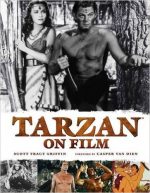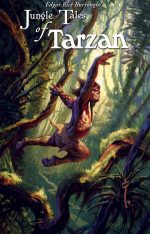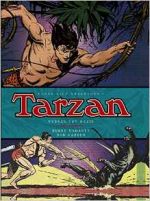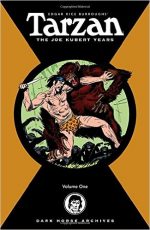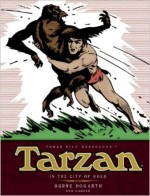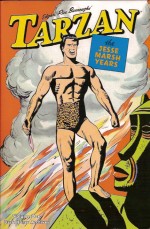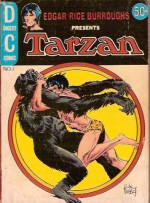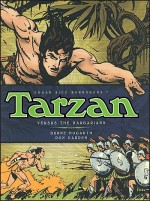
By Burne Hogarth and Don Garden (Titan Books)
ISBN: 978-1-78116-318-4
Modern comics and graphic novels evolved from newspaper comic strips. These daily pictorial features were – until quite recently – overwhelmingly popular with the public and highly valued by publishers who used them as a powerful tool to guarantee and increase circulation and profits. From the earliest days humour was paramount; hence the terms “Funnies†and, of course, “Comicsâ€.
Despite the odd ancestor or precedent like Roy Crane’s Wash  Tubbs (comedic when it began in 1924, but gradually moving through mock-heroics to light-action to become a full-blown adventure serial with the introduction of Captain Easy in 1929), the vast bulk of strips produced were generally feel-good humour strips with the occasional child-oriented fantasy.
The full blown dramatic adventure serial started with Buck Rogers on January 7th 1929 – and Tarzan which debuted the same day. Both were adaptations of pre-existing prose properties and their influence changed the shape of the medium forever.
The 1930s saw an explosion of such fare, launched with astounding rapidity and success. Not just strips but actual genres were created in that decade which still impact on today’s comic-books and, in truth, all our popular fiction forms.
In terms of sheer quality of art, adaptations of Edgar Rice Burroughs’ novels starring jungle-bred John Clayton, Lord Greystoke by Canadian commercial artist Harold “Hal†Foster were unsurpassed, and the strip soon became a firm favourite of the masses, supplementing movies, books, a radio show and ubiquitous advertising appearances.
As fully detailed in the previous volume of this superb oversized (330 x 254mm), full-colour hardback series, Foster initially quit the strip at the end of the 10-week adaptation of the first novel Tarzan of the Apes. He was replaced by Rex Maxon, but returned (at the insistent urging of Edgar Rice Burroughs) when the black-&-white daily was expanded to include a lush, full colour Sunday page featuring original adventures.
Leaving Maxon to capably handle the Monday through Saturday series of novel adaptations, Foster produced the Sunday page until 1936 (233 consecutive weeks) after which he momentously moved to King Features Syndicate to create his own landmark weekend masterpiece Prince  Valiant in the Days of King Arthur – which debuted on February 13th 1937.
Once the four month backlog of material he had built up was gone, Foster was succeeded by a precociously brilliant 25-year old artist named Burne Hogarth: a young graphic visionary whose superb anatomical skill, cinematic design flair and compelling page composition revolutionised the entire field of action/adventure narrative illustration. The galvanic modern dynamism of the idealised human figure in today’s comicbooks can be directly attributed to Hogarth’s pioneering drawing and, in later years, educational efforts.
When he in turn left the strip Hogarth eventually found his way into teaching (he was the co-founder – with Silas H. Rhodes – of the Cartoonist and Illustrators School for returning veterans which evolved into the New York School of Visual Arts) and also created an invaluable and inspirational series of art textbooks such as Dynamic Anatomy and Dynamic Figure Drawing, which influenced generations of aspiring artists.
In the early 1970s Hogarth was lured back to the leafy domain of the legendary Lord Greystoke, producing two magnificent volumes of graphic narrative in the dazzling style that had captivated audiences more than thirty years previously. Large bold panels, vibrantly coloured, with blocks of Burroughs’ original text, leapt out at the reader in a riot of hue and motion as they retold the triumphant, tragic tale of the orphaned scion of the British nobility raised to puissant manhood by the Great Apes of Africa in Tarzan of the Apes and The Jungle Tales of Tarzan.
Burroughs cannily used the increasingly popular strip feature to cross-market his own prose efforts with great effect. Tarzan and the City of Gold was first serialised in the pulp magazine Argosy in 1932 and released as a book the following year. In May 1936, Foster’s new – and unconnected – Tarzan in the City of Gold could be described as a brand new adventure on one hand, whilst boosting already impressively constant book sales by acting as a subtle weekly ad for the fantastic fantasy novel.
This second sublime collection begins with fascinating original art examples peppering the ‘Introduction’ by sometime Tarzan and current Prince Valiant illustrator Thomas Yeates, who shares memories of and commentary on Hogarth the man, the exemplar and the educator.
The visual virtuosity then resumes with ‘Tarzan and the Peoples of the Sea and the Fire’ (episodes #478-527-8, 5th May 1940 to April 20th 1941) wherein the ape-man, incessantly journeying across fantastic, unexplored Africa, discovers an inland sea and stumbles into an ages-old war between two lost races.
On the one side are the water-worshipping mariners of the Sea People whose vile Prince Jagurt captures Tarzan whilst beautiful maiden Leecia is falling for him. Sadly, the real problem is arch-priest Molocar, who takes an instant dislike to the newcomer and tries to feed him to the Demon-fish…
Escaping the antediluvian ichthyosaurs, the jungle lord stumbles upon secret subterranean caverns where the priesthood perfect their seemingly supernatural tricks to cow the populace. The surprised superstition-peddlers try to make him a slave…
Within the compound Tarzan meets a warrior of the city’s ancestral enemies, the volcano-worshipping Fire People, and discovers a crippled boy named Prince Tanny. The child is heir to the lava-lovers’ throne and Molocar intends to brainwash and torture him into switching faiths…
The ape-man cannot abide cruelty and in a fit of righteous rage frees the boy and breaks out of the den of iniquity. Eluding the prowling demon-fish, Tarzan swims the lagoon with his frail prize, moving into the city, where after sustained pursuit he elicits Leecia’s aid. After many savage battles they flee together into the dense jungle.
The plan had been to take Tanny home, but since the boy’s capture his father has been murdered and Towrit the Cruel now rules the Fire People. When the trio are intercepted by the usurper’s soldiers only Tarzan and the boy break free, but after hiding in a cave the jungle lord is ambushed by a ferocious giant who turns out to be the boy’s faithful guardian Jaxie…
Resolved to free Leecia and restore Tanny to the throne, Tarzan’s herculean efforts are thwarted as all-out war begins. The implacable hatred of each faction for him and each other results in constant battle, but as Jagurt, Molocar and Tawrit all strive for supremacy nature itself rebels and the entire region is devastated when the volcano erupts, imperilling all dwellers around the inland sea…
Lost World romance gave way to modern militaristic mayhem in ‘Tarzan Against Dagga Ramba’ (pages #529-581, running from 27th April 1941 to 26th April 1942). Having sailed a river to a great desert, the mighty wanderer encounters a camel caravan in time to save an Arabian princess from a stalking leopard, although it leaves him grievously injured.
Haughty Ta’ama much prefers the wild man saviour to her own (arranged) affianced man, something rapacious Sheik Numali is not going to allow. The caravan continues with comatose Tarzan guarded by the Princess, but Numali knows that sooner or later her attention will lapse and an accident can be made to happen…
Happily the white god recovers before any untoward occurrences but agrees to remain with them until the Great Desert is crossed. Into that simmering bath of tension and suspicion a greater menace soon intrudes as ambitious army sergeant Dagga Ramba abandons the war currently engulfing North Africa, declares himself general and convinces a band of Askari deserters they can carve out their own kingdom in the sands…
When the caravan is captured by the soldiers Tarzan escapes and stumbles upon old ally Kamur and his mountain-living Ibek Nomads. The doughty warrior is stalking the Askaris who have stolen his wife Nikotris, but that noble woman is in far greater danger from her fellow captive Ta’ama than the self-appointed warlord.
The mountain dweller has idly expressed her (platonic) admiration for Tarzan in the cell they share and the ruthless Arabian princess has wrongly deduced she has a rival for the ape-man’s affections…
Thankfully a daring raid of the warlord’s fortress by Tarzan liberates Kamur’s bride before Ta’ama can act, but in the melee he is trapped and, after soundly thrashing Dagga Ramba, sentenced to hang. Casually but spectacularly escaping the gallows, the hero rapidly returns to the mountains unaware the warlord has subtly suborned noxious Numali…
Soon a guerrilla war is underway at great cost to the Ibeks, whose bows and raw courage are no match for machine guns and armoured cars. Tarzan volunteers to re-cross the desert and try to recruit the normally impartial Soufara into a grand alliance against Dagga Ramba.
His brief time with nomadic Bedouins garners no support but their initial refusal only allows the upstart warmonger to mount a surprise attack on the desert dwellers. Racing out into a sandstorm on a stolen camel, Tarzan heads for the Soufara with Numali in hot pursuit.
When his mount expires the indomitable ape-man continues his epic trek on foot and eventually reaches their forbidden city, only to find gloating Numali waiting for him.
His attempts to assassinate the ape-man are forestalled by the Emir (Ta’ama’s father), but the potentate is disdainful of the warning Tarzan brings. Only Numali is aware that Dagga Ramba’s army is approaching and will soon attack the overconfident walled metropolis…
With his daughter hostage the Emir is hopeless to resist a mechanised assault and promptly names Tarzan his War Sheik. The noble savage’s ideas on what we now call asymmetrical warfare soon stem the tide and when he abandons the battle to call the Ibeks into the fray, it spells the beginning of the end for the dreams of Dagga Ramba…
Job done, Tarzan slips away and traverses the mountains until washed by a tumult into a lush, isolated valley where two unlikely westerners are exploring…
‘Tarzan and the Fatal Mountain’ (#582-595, 3rd May – 2nd August 1942) returned to high fantasy as murderous dwarf Kalban Martius takes an instant dislike to the tall, clean-limbed dark Adonis whilst his reluctant companion and unwitting target object d’amour Olga finds her heart all a-flutter…
The Europeans were exploring the valley with Olga’s scientist father who had discovered the place to be rife with oversized lifeforms. Even the generally peaceful white natives dubbed the Kolosans average eight feet tall. In fact almost everything was bigger but more passive…
After Martius fires a few shots at Tarzan – and is easily eluded and subdued – the ape-man is befriended by Olga who explains they were looking for the secret of the Kolosans’ immensity. Later the giants take him into their confidence whilst explaining that he can never escape the steep encircling escarpments back to his own world…
The giants also reveal an ancient temple where a lizard-shaped “forbidden fountain†spews forth a vile liquid. The tribal secret is unfortunately exposed by Martius who had covertly joined the party, and when he stole some of the evil water it instantly transformed him into a brutal gargantuan twice the size of the Kolosans…
Crazed with dreams of power the beast-man flees, taking a canteen full of the wicked liquid. Soon the gentle valley is filled with his aggressive army of super-giants and Tarzan is forced to lead the Kolosans into a final cataclysmic battle for survival…
Eventually the carnage subsides and Olga reveals how they will leave the hidden valley. She, her father and Kalban had arrived by airplane and Tarzan can go back with them. Sadly, one final catastrophe looms as their take-off is interrupted by a super-ape which had swallowed some of Martius’ stolen growth toxin…
Following a stupendous duel on the ship’s wing Tarzan returns to the relative safety of the cockpit but as they fly on the voyagers encounter an RAF plane going down in a death-spiral over a murky island…
‘Tarzan and the Barbarians’ (#596-659, 9th August 1942 to 24th October 1943) opens with the ape-man parachuting out of Olga’s plane – and life – to assist the downed pilot. Wing Commander Jonathan is badly hurt, but before Tarzan can administer aid he is interrupted by a bizarre stranger. Nahro the Hermit wants them gone and has decided to hunt the pair for sport…
The swampy terrain quickly proves the madman’s downfall, after which Tarzan carries his ailing charge across lethal trees through mire past deadly beasts until they are captured by brutal warriors who look like Vikings…
The barbarians are dismissive of their captives as they carry them up a huge mesa to their stony citadel. Although threatened with death Tarzan eschews an easy escape by refusing to marry one of the warrior’s women and earns the undying enmity of the shamed Hilsa.
Penned with other captives he meets the slave Leeta and learns the mesa-marauders have been preying on the region’s inhabitants for centuries. When he tries to carry her away to safety, Hilsa is waiting and ambushes them…
Forced to flee alone, Tarzan heads for Leeta’s village seeking men to mount a rescue mission for her and the British pilot. However the chieftain’s wizard ignores his entreaties and instead prepares to undertake a venerable custom. The Berian people have always sacrificed the strongest heroes in their midst so the warrior could travel to the departed ancestors and beseech supernatural aid.
Tarzan ferociously suggests that they stop killing the best fighters and use them to actually fight the barbarians…
To aid their assault he even introduces them to the concept of aerial warfare, engineering the construction of a giant balloon from sewn animal hides…
The skyborne blitzkrieg fails and Tarzan plunges into a vast cave in the centre of the mesa, but this fortuitously exposes the citadel’s great weakness – a secret tunnel leading to the plains below, big enough for a small force of men to use in a sneak attack…
After much travail and bloodshed the plan succeeds but even in victory Tarzan can find no peace. Ferrying Jonathan back to civilisation leads to another primitive city, another lusty lass and one more jealous suitor and before long the ape-man is embroiled in a brutal war where the balance of power rests with the side that can muster the most mastodons…
The most worrying aspect of the war is that it is being fought for ownership of a huge jewel which can cause instant death…
Although the battle eventually goes to the just, it exposes Jonathan’s true colours as he tries to seize the lethal death-ray device for his country and especially himself…
Fed up with humans, Tarzan heads back into the wild woods only to encounter old “friends†when arboreal amazon Tibeela ambushes the man who once eluded her amorous advances. This time she takes no chances and knocks him unconscious before making her move…
Her scheme might have worked had not a band of roving buccaneers chosen that moment to come to the forest hunting women for slaves, leading to another uncanny escapade against a decadent king in a debased kingdom as well as three uncanny reunions… with an ape, a lion and a Boer beside whom Tarzan had battled before…
These tales are full of astounding, unremitting, unceasing action with Hogarth and scripter Don Garden spinning page after page of blockbuster Technicolor epics over months of non-stop wonder and exotic adventure. Plot was never as important as engendering a wild rush of rapt and rousing visceral response and every Sunday the strip delivered that in spades.
Edgar Rice Burroughs was a master of populist writing and always his prose crackled with energy and imagination. Hogarth was an inspired intellectual and, as well as gradually instilling his pages with ferocious, unceasing action, layered the panels with subtle symbolism. Heroes looked noble, villains suitably vile and animals powerful and beautiful. Even vegetation, rocks and clouds looked spiky, edgy and liable to attack at a moment’s notice…
These vivid visual masterworks are all coiled-spring tension or vital, violent explosive motion, stretching, running, fighting: a surging rush of power and glory. It’s a dream come true that these majestic exploits are back in print – especially in such a lavish and luxurious oversized (330 x 254 mm) hardback format – for ours and future generations of dedicated fantasists to enjoy.
Magnificent, majestic and awe-inspiring.
Tarzan ® & © 2014 Edgar Rice Burroughs, Inc. All Rights Reserved. All images copyright of Edgar Rice Burroughs, Inc 2014. All text copyright of Edgar Rice Burroughs, Inc 2014.
